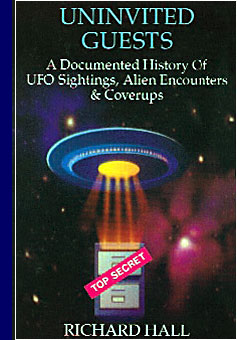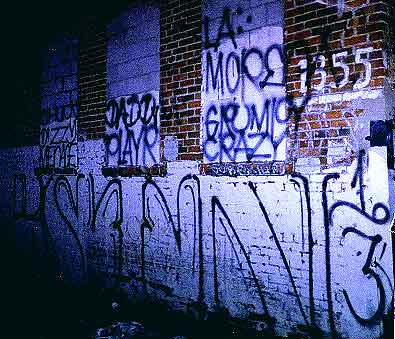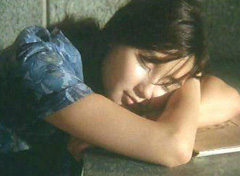Nevertheless, they still appear. The Chicago Tribune reported (registration required) on Jan. 1, 2007, a sighting at O'Hare Aiprort:
A flying saucerlike object hovered low over O'Hare International Airport for several minutes before bolting through thick clouds with such intense energy that it left an eerie hole in overcast skies, said some United Airlines employees who observed the phenomenon. … The sighting occurred during daylight, about 4:30 p.m., just before sunset.Until recently I had not taken more than a casual interest in UFO phenomena. While by no means a hard-core skeptic, I was repelled by the large volume of quite loony stuff written on the subject — to see what I mean, search Amazon.com under the heading "UFO" — and the nearly inexhaustible claims and theories. It is as though UFOs are similar to Rorschach test ink blots, interpreted according the assumptions and personality anyone brings to them.
All the witnesses said the object was dark gray and well defined in the overcast skies. They said the craft, estimated by different accounts to be 6 feet to 24 feet in diameter, did not display any lights. Some said it looked like a rotating Frisbee, while others said it did not appear to be spinning. All agreed the object made no noise and it was at a fixed position in the sky, just below the 1,900-foot cloud deck, until shooting off into the clouds.
"I tend to be scientific by nature, and I don't understand why aliens would hover over a busy airport," said a United mechanic who was in the cockpit of a Boeing 777 that he was taxiing to a maintenance hangar when he observed the metallic-looking object above Gate C17. "But I know that what I saw and what a lot of other people saw stood out very clearly, and it definitely was not an [Earth] aircraft," the mechanic said.
I did have some sympathy with whatever serious and level-headed UFO researchers might be out there, since it appeared that they suffered at the hands of the same kind of boneheaded scientists who have held back the progress of psychical research, a field of which I am an amateur devotee. These are the scientists who won't look at evidence if it contradicts their view of fundamental natural laws and what they "know" can and can't be. Robert A. Heinlein compared them to the yokel who saw a rhinocerous for the first time and said, "There ain't no such animal."
Still, I figured I didn't have time to read a dozen books to get my bearings and work out which UFO researchers might be credible and what the evidence suggested. But by luck, synchronicity, mysterious plan or what you will, I happened to run across a copy of Uninvited Guests, by Richard Hall, at a library book sale. The subtitle ("A Documented History of UFO Sightings, Alien Encounters and Coverups") wasn't entirely promising — conspiracy theories are meat and potatoes to UFO buffs — but I glanced through it anyway. The tone of the writing impressed me as sane, and a glance at the author's bio note told me he'd played major roles in several of the most respected military-sponsored and civilian UFO studies, including the famous National Investigation Committee on Aerial Phenomena (NICAP). So I spent a buck on the book in the hope that this might be the key to the subject that I had been looking for.

Uninvited Guests was published in 1988. Hall has more recently updated it with The UFO Evidence, although it appears from the Amazon.com reviews that he has not basically changed his outlook. Hall strikes me as the right man for the job of collecting and analyzing the bizarre, and often disturbing, evidence of UFO encounters, as well as such alleged phenomena as seeing or being abducted by extraterrestrials. He acknowledges that (as with many psychical phenomena) there is no absolute proof of UFOs or aliens. He agrees that many claimed sightings are the product of unusual natural phenomena or deranged minds.
But — again as in psychical research — unless you believe that hundreds of psychologically normal, not overimaginative and responsible people all over the world are involved in a pointless hoax or were hallucinating for no known reason, they have experienced UFOs.
Hall considers a large number of anecdotes, including stories about bodies of aliens from crashed UFOs kept secretly at military bases. (He's agnostic on that one — there are a few seemingly credible witnesses in the files, but he shows that a video circulated among "saucer" buffs of a supposed alien autopsy is a fraud.) There are discussions of many theories about the nature of UFOs, including such "sophisticated" ones as Carl Jung's that UFOs are some sort of mass projection of archetypes in a contemporary form, or that they are visitors from the past, the future, or a parallel universe. Time travel hypotheses involve well known paradoxes, and Hall quite reasonably points out that to claim UFOs as tourists from "another dimension" or "parallel universe" is logically and scientifically meaningless.
Hall believes that, taking the evidence as a whole into account, the extraterrestrial hypothesis (which UFO researchers abbreviate ETH) is the most likely. He isn't dogmatic about it; it's just that after more than 20 years (at the time of writing) of direct involvement in the subject, checking documentation and reading eyewitness interviews conducted by people known to him to be of sound mind, every other theory requires assumptions that are even harder to swallow than the ETH.
If you are curious about UFO phenomena, but lack the time or inclination for an in-depth study, here are some of the tentative conclusions, observations, and surmises that Hall's book leads to:
1. "Flying saucers" are only one configuration of observed UFO. Most are round (horizontally) and relatively flat (vertically), often with a dome on the top or bottom, sometimes with windows or "portholes" in the dome; but others appear elongated. Some are described as spinning. Color is often silver (matte or reflective), sometimes gray. Colored lights are often reported on the object, and sometimes beams of light emerge from it. Descriptions of size vary widely, from a few feet to hundreds of feet.
2. They maneuver at fantastic trajectories that seem to defy the known laws of physics, and at speeds from hovering to several thousand mph. They may be seen at any altitude but a surprising (to me) number appear near or occasionally at ground level. They play "cat-and-mouse" games, traveling over, in front of, or behind cars or aircraft, often quite close.
3. They are associated with disturbances in electromagnetic fields. In the vicinity of UFOs, engines and electrical equipment frequently stop, then resume when the UFO leaves.
4. Human viewers or experiencers sometimes, though not always, exhibit psychological or physical symptoms afterward.
5. There have been periods of heavy UFO activity interrupted by relative lulls. Sightings go back at least a hundred years, or much longer depending on what evidence you accept, but they started in earnest post-World War II. At first, they just appeared in the sky; then (roughly, in the '60s) began to initiate "close encounters"; later, in the '70s, reports of appearances of aliens and abductions started coming to the fore. In recent years, there have been much-publicized cases of people remembering being probed and studied aboard spaceships, recalled under hypnosis.
6. "Aliens" are often described as little, though not green, men (and sometimes women). They, too, seem to vary considerably in physiology. "Humanoid" is an often-used term. Although most reports speak of creatures only three or four feet high, there are a few reported giants.
What on earth (or not of the earth) are we to make of all this?
Obviously, if UFOs are interplanetary craft, there are many kinds. It also appears that the extraterrestrials, if such they are, are of different species or races.
Why are they here? Their behavior suggests that they are studying us; their motives can hardly be guessed because we don't know anything about their psychology or culture. It is possibly significant that while people who encounter UFOs, particularly those who say they have seen "aliens," are often scared out of their wits, there is little evidence of any overtly hostile activity on the intruders' part. While the ETs have technology far in advance of our own, Hall suspects they are not omniscient. (If they were, why would they need to study humans?) He thinks it possible that even some of the terrifying examinations and occasional damage to equipment might be the result of ignorance or clumsiness ("Oops, that needle in the navel was not supposed to hurt"; "that plane got too close and we didn't mean to damage it").
Hall (and many other UFO researchers) speculate that the UFO crews are preparing us for an eventual meeting, getting us used to the idea gradually so we won't be totally shocked and panicked when the time comes. The evidence so far does indicate that with the astonishing technology available to them, these ETs could clean our clocks with no trouble at all if some War of the Worlds type of invasion was on their minds, and they haven't.
All this, mind you, is speculation. But as speculation goes, Hall's seems to be as sensible as any, and a lot more so than much of it about this perplexing subject.
But — again as in psychical research — unless you believe that hundreds of psychologically normal, not overimaginative and responsible people all over the world are involved in a pointless hoax or were hallucinating for no known reason, they have experienced UFOs.
Hall considers a large number of anecdotes, including stories about bodies of aliens from crashed UFOs kept secretly at military bases. (He's agnostic on that one — there are a few seemingly credible witnesses in the files, but he shows that a video circulated among "saucer" buffs of a supposed alien autopsy is a fraud.) There are discussions of many theories about the nature of UFOs, including such "sophisticated" ones as Carl Jung's that UFOs are some sort of mass projection of archetypes in a contemporary form, or that they are visitors from the past, the future, or a parallel universe. Time travel hypotheses involve well known paradoxes, and Hall quite reasonably points out that to claim UFOs as tourists from "another dimension" or "parallel universe" is logically and scientifically meaningless.
Hall believes that, taking the evidence as a whole into account, the extraterrestrial hypothesis (which UFO researchers abbreviate ETH) is the most likely. He isn't dogmatic about it; it's just that after more than 20 years (at the time of writing) of direct involvement in the subject, checking documentation and reading eyewitness interviews conducted by people known to him to be of sound mind, every other theory requires assumptions that are even harder to swallow than the ETH.
If you are curious about UFO phenomena, but lack the time or inclination for an in-depth study, here are some of the tentative conclusions, observations, and surmises that Hall's book leads to:
1. "Flying saucers" are only one configuration of observed UFO. Most are round (horizontally) and relatively flat (vertically), often with a dome on the top or bottom, sometimes with windows or "portholes" in the dome; but others appear elongated. Some are described as spinning. Color is often silver (matte or reflective), sometimes gray. Colored lights are often reported on the object, and sometimes beams of light emerge from it. Descriptions of size vary widely, from a few feet to hundreds of feet.
2. They maneuver at fantastic trajectories that seem to defy the known laws of physics, and at speeds from hovering to several thousand mph. They may be seen at any altitude but a surprising (to me) number appear near or occasionally at ground level. They play "cat-and-mouse" games, traveling over, in front of, or behind cars or aircraft, often quite close.
3. They are associated with disturbances in electromagnetic fields. In the vicinity of UFOs, engines and electrical equipment frequently stop, then resume when the UFO leaves.
4. Human viewers or experiencers sometimes, though not always, exhibit psychological or physical symptoms afterward.
5. There have been periods of heavy UFO activity interrupted by relative lulls. Sightings go back at least a hundred years, or much longer depending on what evidence you accept, but they started in earnest post-World War II. At first, they just appeared in the sky; then (roughly, in the '60s) began to initiate "close encounters"; later, in the '70s, reports of appearances of aliens and abductions started coming to the fore. In recent years, there have been much-publicized cases of people remembering being probed and studied aboard spaceships, recalled under hypnosis.
6. "Aliens" are often described as little, though not green, men (and sometimes women). They, too, seem to vary considerably in physiology. "Humanoid" is an often-used term. Although most reports speak of creatures only three or four feet high, there are a few reported giants.
What on earth (or not of the earth) are we to make of all this?
Obviously, if UFOs are interplanetary craft, there are many kinds. It also appears that the extraterrestrials, if such they are, are of different species or races.
Why are they here? Their behavior suggests that they are studying us; their motives can hardly be guessed because we don't know anything about their psychology or culture. It is possibly significant that while people who encounter UFOs, particularly those who say they have seen "aliens," are often scared out of their wits, there is little evidence of any overtly hostile activity on the intruders' part. While the ETs have technology far in advance of our own, Hall suspects they are not omniscient. (If they were, why would they need to study humans?) He thinks it possible that even some of the terrifying examinations and occasional damage to equipment might be the result of ignorance or clumsiness ("Oops, that needle in the navel was not supposed to hurt"; "that plane got too close and we didn't mean to damage it").
Hall (and many other UFO researchers) speculate that the UFO crews are preparing us for an eventual meeting, getting us used to the idea gradually so we won't be totally shocked and panicked when the time comes. The evidence so far does indicate that with the astonishing technology available to them, these ETs could clean our clocks with no trouble at all if some War of the Worlds type of invasion was on their minds, and they haven't.
All this, mind you, is speculation. But as speculation goes, Hall's seems to be as sensible as any, and a lot more so than much of it about this perplexing subject.





